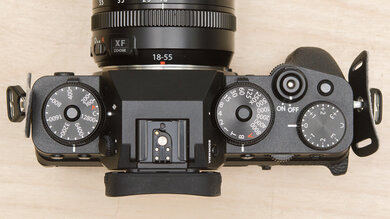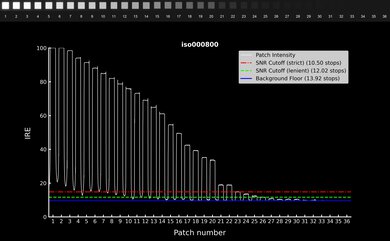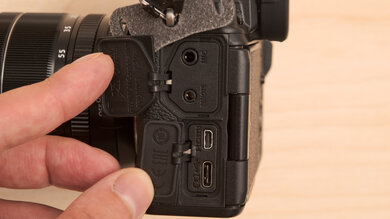The Fujifilm X-T4 is a mirrorless APS-C camera. With a sturdy, weather-sealed body and dedicated exposure dials, it embodies the old-school shooting experience that Fujifilm is known for. Add to that its relatively portable size, in-body image stabilization (IBIS), and solid video specs, and you've got a well-rounded camera for hobbyists and hybrid shooters.
Our Verdict
The Fujifilm X-T4 is good for travel photography. It delivers very good image quality overall, and Fuji's X mount features a wide range of portable lens options. Though the body is on the heavier side, it's still relatively portable, and it's very well-built, with a robust weather-sealed build. It also has a great battery life for a mirrorless model. That said, its autofocus tracking isn't the most consistent, especially in busier settings. Its ergonomics can take some getting used to as well.
- Very good image quality.
- Impressive build quality.
Relatively portable.
- Somewhat heavy.
- AF tracking can be unreliable.
The Fujifilm X-T4 is very good for landscape photography. It takes high-quality images, with a good amount of dynamic range to bring out more detail in high-contrast landscapes. It also does pretty well in low light, though its noise handling is just decent. It's a fairly portable camera with a relatively long battery life, though it's on the heavier side, and its ergonomics can take getting used to.
- Very good image quality.
- Impressive build quality.
Relatively portable.
- Somewhat heavy.
The Fujifilm X-T4 is good for sports and wildlife photography. It can shoot at very high continuous shooting speeds, and it has an effective autofocus system overall. That said, its AF tracking feature isn't the most reliable with very quick or erratic subjects. It also has a small image buffer and takes a long time to empty once full, which can interrupt your shooting.
- Very good image quality.
- Impressive build quality.
- High maximum shooting speed.
- Somewhat heavy.
- AF tracking can be unreliable.
Small photo buffer.
The Fujifilm X-T4 is good for vlogging. Its fully articulated screen lets you easily monitor what you're recording, while its in-body stabilization feature keeps handheld videos stable. Its autofocus system also does an excellent job of tracking and maintaining focus on your face as you record. That said, it imposes a 30-minute time limit on video recordings, and it isn't the smallest or lightest camera for on-the-go vlogging.
- Fully articulated, high-resolution screen with good brightness.
- Impressive video quality.
Effective video autofocus.
- Somewhat heavy.
Time limit on recording.
The Fujifilm X-T4 is great for studio video. Video quality is excellent, and it has great internal recording capabilities, with internal 10-bit capture and Log recording. However, it's limited to 4:2:0 subsampling internally and has a 30-minute time limit on recording. Unfortunately, it lacks a dedicated headphone jack, necessitating the use of a clunky USB-C adapter, which means giving up external power delivery if you want to monitor your audio in-camera.
- Impressive video quality.
Effective video autofocus.
Internal 10-bit recording and Log support.
- No built-in headphone jack.
Time limit on recording.
Limited to 4:2:0 chroma sampling internally.
The Fujifilm XT4 isn't designed for POV action video. It isn't small enough to be mounted on a head rig or other action video rigs, and it isn't waterproof. That said, it's sturdy and weather-sealed. It also offers great video recording quality, and it has a fair amount of frame rate options, including a dedicated slow-motion recording mode that can capture 1080p footage at up to 240 fps.
- Impressive video quality.
- Supports 120 fps and 240 fps recording with slow motion playback.
Effective video autofocus.
- Somewhat heavy.
- Not waterproof.
Time limit on recording.
The Fujifilm X-T4 has good RAW photo performance. It has good dynamic range to bring out more detail in high-contrast scenes. Its high-resolution sensor also does a great job of resolving fine detail, even when you punch in. That said, its noise performance in low light is only decent, though you can still get good results depending on your lens.
- Good dynamic range.
- Photos look quite sharp and detailed.
- Noise handling is just decent.
Performance Usages
Changelog
-
Updated Jan 21, 2025:
We added full text and revised the existing text to bring the review up to our current standards of quality.
- Updated Dec 12, 2024: We've converted this review to Test Bench 0.13. We've added new tests for Video Dynamic Range and Luminosity Patch Detection. You can learn more about these updates in the changelog.
- Updated Jan 29, 2024: Added text to the 'Raw Photo Performance' verdict box and updated existing verdict boxes for clarity and accuracy.
- Updated Jan 29, 2024: Converted to Test Bench 0.12.1.
Check Price
Differences Between Sizes And Variants
The Fujifilm X-T4 comes in two color variants: Black and Silver. We purchased the Black variant with the FUJINON XF 18-55mm F/2.8-4 R lens; here's the label for our unit. We expect the Silver variant to perform the same.
You can also buy it in either color scheme with the FUJINON XF 16-80mm f/4 R OIS WR lens or without a lens at all, depending on the retailer.
Popular Camera Comparisons
The Fujifilm X-T4 is a well-rounded hybrid camera. While it falls behind full-frame competitors like the Canon EOS R6 and Sony α7 III in areas like dynamic range and noise handling, it's an excellent all-arounder that still captures great image quality, with a relatively portable, sturdy build to boot. Throw in the unique Fuji shooting experience, with dedicated exposure dials and film simulation profiles, and you have a versatile hybrid camera that's fun to shoot.
For other options, check out our recommendations for the best mirrorless cameras for travel, the best cameras for video, and the best cameras we've tested overall.
The Fujifilm X-T5 marks a return to the photography-oriented roots of the X-T series after the more hybrid design of the Fujifilm X-T4. Both are very capable cameras for photography and video, but the fully articulated screen of the X-T4 is better suited to video work, while the three-way tilting screen of the X-T5 is better for photography. The X-T5 is just a touch lighter and more portable, and its new high-resolution sensor captures more detailed photos with more cropping leeway.
The Fujifilm X-T4 is better overall than the Fujifilm X-T30 II, though they both use the same sensor, so image quality is roughly on par between them. If you prefer a more robust camera with weather-sealing, a bigger high-resolution viewfinder, and a fully articulated screen, get the X-T4. If you're looking for something smaller and easier to carry around, the X-T30 II is still a great option. However, the X-T4 also has better internal video recording capability, so it's a better option for video work.
The Fujifilm X-H2 and the Fujifilm X-T4 are both excellent APS-C cameras, but they're aimed at slightly different users. The X-H2 is a bit more powerful, with a higher-resolution sensor, upgraded autofocus system, and video recording in up to 8k resolution. However, it's a lot bulkier than the Fujifilm X-T4, which is the better choice for users who want a more portable hybrid camera.
The Sony α7 IV and the Fujifilm X-T4 are both great hybrid photo/video cameras, but they use different-sized sensors. Because the Fujifilm uses an APS-C sensor, it's more portable than the Sony, but both cameras are well-built, are weather-sealed, and have fully articulated touchscreens. The Fuji also has a faster max burst rate and better overall stabilization. On the other hand, the Sony's full-frame sensor gives it better low-light and high-ISO performance and better dynamic range. When it comes to video, both cameras can shoot 4k / 60 fps, although the Sony incurs a larger crop at this frame rate, and they can both record 10-bit 4:2:2 video internally. While the higher-resolution full-frame sensor on the Sony offers some advantages over the Fujifilm, the Fuji is still competitive, especially if you prefer a more compact form factor.
Test Results

The Fujifilm X-T4 is fairly portable, especially compared to most full-frame hybrid cameras. It has a small grip that keeps its size down, though it's a bit on the heavier side. Still, for most shooters, it won't cause too much fatigue.
The build quality here is excellent. The camera is made of sturdy magnesium alloy and feels very solidly built, with weather-sealing to keep out dust and moisture. The buttons and dials all feel of high quality, and the dials aren't loose or easy to change by accident. The screen mechanism also feels very sturdy. While the SD card slots and battery compartment are covered with hinged doors, the inputs on the side of the camera only have rubber flaps.
The camera's ergonomics are decent. The camera is large enough for most hand sizes, and the textured grip around the body feels secure, but it's not the deepest hand grip, so it can be a bit slippery, especially if you have larger hands. For a larger grip, you'll have to look to more pro-oriented hybrid models like the Fujifilm X-H2 or Fujifilm X-H2S. Like most Fujifilm cameras, the X-T4 has dedicated physical controls for ISO, shutter speed, and exposure compensation, making it easy to adjust exposure settings without diving into the menu. That said, the eyecup around the viewfinder is a bit stiff, and the shoulder strap attachment points are somewhat in the way.
The EVF is quite large, with a relatively high resolution. While some newer cameras have even higher resolutions, like the Fujifilm X-H2S, you'll still have a sharp, clear view here.
The camera has a fully articulated screen. It's quite bright for use in sunnier conditions, and it has a relatively high resolution. It's not quite as high as the screen on the Fujifilm X-T5, which also features a 3-way tilting design, but it's sharp enough. Touch functions are limited to selecting focus points or changing settings while recording videos.
The menu is fairly simple and easy to navigate, though some settings are buried in submenus and harder to find. Thankfully, the camera includes visual graphics for certain settings and functions, though there's no additional info button or 'guide' mode. Fujifilm also uses its own terminology for certain settings, like 'photometry' for metering settings, which can take some getting used to. But overall, it's pretty intuitive.
The Fujifilm X100V is also compatible with Fujifilm's XApp, which Fujifilm claims to offer smoother wireless connectivity between X series cameras and smartphones than the older Fujifilm Camera Connect app. You can use it to transfer files or control the camera remotely.
The Fujifilm X-T4 uses a fourth-generation 26 MP X-Trans sensor and the X-Processor 4. It has a fairly wide ISO range and a backside-illuminated design that's intended to improve its light-gathering ability.
The Fujifilm X-T4 has a great battery life. It's CIPA-rated for 500 shots on a full charge, which is great, especially among mirrorless cameras. However, these ratings don't necessarily align with real-world numbers, so you're mileage will vary depending on how you use your camera.
Its video battery life is decent, lasting for about an hour and a half of 4k video recording. That's fairly middle of the road, but if you need to extend the battery life, you can use an external power source.
The Fujifilm X-T4 can shoot at a quick max burst rate. Its mechanical burst rate maxes out at approximately 12 fps, which is excellent, and with the electronic shutter, it can shoot at up to 20 fps. While newer models, like the Fujifilm X-T5, have improved further, the X-T4 is still great for continuous shooting.
Unfortunately, however, the photo buffer fills up quite quickly when shooting in RAW format, and once full, it takes a long time to empty, which can interrupt your shooting. In JPEG, the buffer is notably bigger, but will still fill up after about 160-170 frames.
The camera uses a hybrid autofocus system. It includes a few different area modes and a 'Tracking' mode in AF-C that follows any subject beneath your focus point. In addition, there's a Face/Eye detection system that can automatically detect and track human faces or eyes. Overall, however, the tracking system is inconsistent. With faster or more erratic subjects, it can struggle to keep up, resulting in a disappointing keeper rate. For a Fujifilm camera with improved AF tracking, check out the Fujifilm X-H2S.
If you disable tracking and stick to a center focus point, the camera has very little trouble staying with the subject. As long as you can keep your subject under the focus point, you shouldn't have any issues with autofocus.
We tested AF-C with the FUJINON XF 18-55mm F2.8-4 R OIS.
The camera features in-body image stabilization, and it can also be paired with optically stabilized lenses, like the FUJINON XF 18-55mm F2.8-4 R OIS, with which we tested image stabilization. Using both IBIS and OIS, the camera can capture clear handheld images at very slow shutter speeds. However, stabilization performance can vary with different factors, including but not limited to what lens you use, what focal length you shoot at, and how steady your hands are.
The Fujifilm X-T4 has good dynamic range. It can't capture as wide a range of detail in high-contrast scenes as full-frame cameras like the Sony α7C, and it performs worse here than the newer Fujifilm X-T5. You'll see some highlight clipping or shadow noise in very high dynamic range scenes, but it's solid overall.
The Fujifilm X-T4 has a relatively high resolution sensor, so it can capture a lot of fine detail. You'll have a bit of room to crop your images but not as much as you would with a higher-resolution sensor camera like the Fujifilm X-T5.
The camera has decent noise handling in low light. Noise is a bit more apparent than on full-frame competitors, but for an APS-C sensor, it performs well.
The Fujifilm X-T4 has some great video features for its class. It supports Log shooting in F-Log, and it can output 10-bit 4:2:2 video to a compatible external recorder to get more dynamic range and have more leeway in post. Still, compared to newer models, it's missing certain features, like higher-resolution recording and internal 4:2:2 subsampling.
The camera can capture 4k video at up to 60 fps with just a slight crop at the max frame rate. That's great if you want to record high-speed action or slow your footage down somewhat, though it doesn't support higher frame rates. If you'd like a camera that can record 4k at 60 fps without a crop, check out the Canon EOS R7.
The camera's internal recording capability is good overall, though it has some limitations, especially compared to newer cameras. For one, there's a 30-minute cap on recording, and while it does support internal 10-bit capture, it's limited to 4:2:0 chroma sampling internally. Overall, that's not bad, unless you're shooting footage that requires more keying and work in post. If you need a camera that can do 4:2:2 subsampling internally, consider the Panasonic LUMIX GH5s. The X-T4 can also overheat with prolonged recording sessions, though it isn't too bad overall.
The camera's autofocus performs incredibly well in video. It's very consistent at tracking moving human subjects, even when they move in and out of frame. Its manual object tracking performance is just as good, with smooth and responsive focus transitions.
The camera has noticeable rolling shutter distortion when panning the camera. It's especially pronounced with very quick camera movements.
The Fujifilm X-T4 can record FHD video at up to 60 fps in standard recording. It also has a high speed recording mode that captures 1080p footage at either 120 fps or 240 fps, with slow motion playback at 30 fps. This feature doesn't record any audio and incurs a crop.
The camera's internal recording capability is good overall, though it has some limitations, especially compared to newer cameras. For one, there's a 30-minute cap on recording, and while it does support internal 10-bit capture, it's limited to 4:2:0 chroma sampling internally. Overall, that's not bad unless you're shooting footage that requires more keying and work in post.
The camera's autofocus performs incredibly well in video. It's very consistent at tracking moving human subjects, even when they move in and out of frame. Its manual object tracking performance is just as good, with smooth and responsive focus transitions.
Rolling shutter performance is better in 1080p. While you'll still see some skewing and wobbling with quick camera movements, it's less pronounced than in 4k.
The Fujifilm X-T4 has excellent dynamic range in video. It captures a very wide total dynamic range, with a clean background floor. It's usable dynamic range, however, is more limited, though you can still capture a max of about 12 stops of usable dynamic range. That makes it well-suited to recording in trickier lighting conditions, with plenty of detail retained in the shadows and highlights.
Tested settings:
- Resolution: 4k
- Frame Rate: 30 fps
- Log Format: F-Log
The camera uses a USB-C port for charging, power delivery, and file transfer. It also features a Micro (Type D) HDMI port and includes a mic input. Unfortunately, there's no built-in headphone jack, but the camera does include a 3.5mm-to-USB-C adapter in the box. Still, that means if you need to power the camera externally, you'll have to choose between power delivery and in-camera audio monitoring.






















